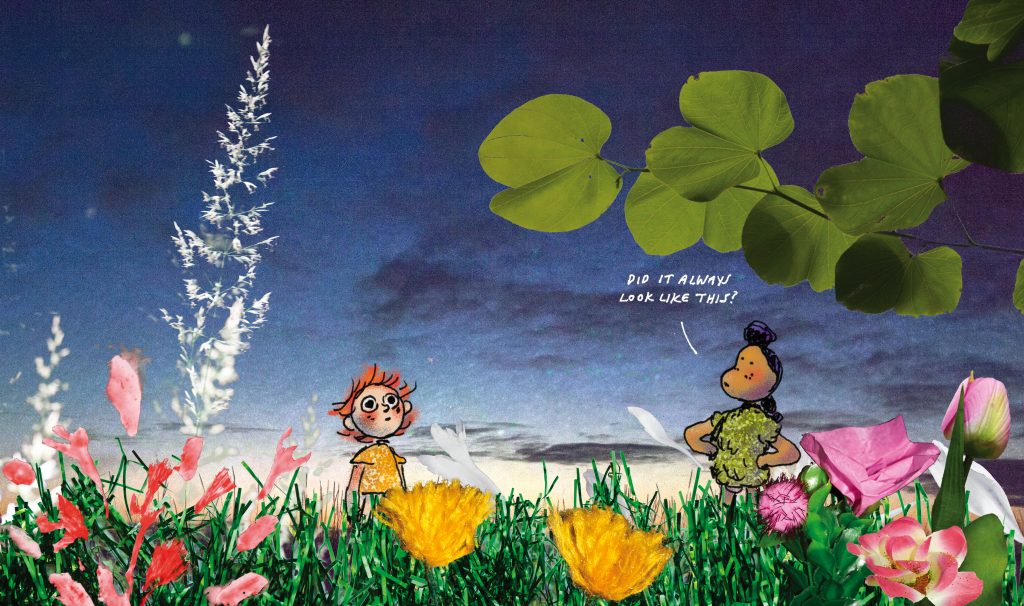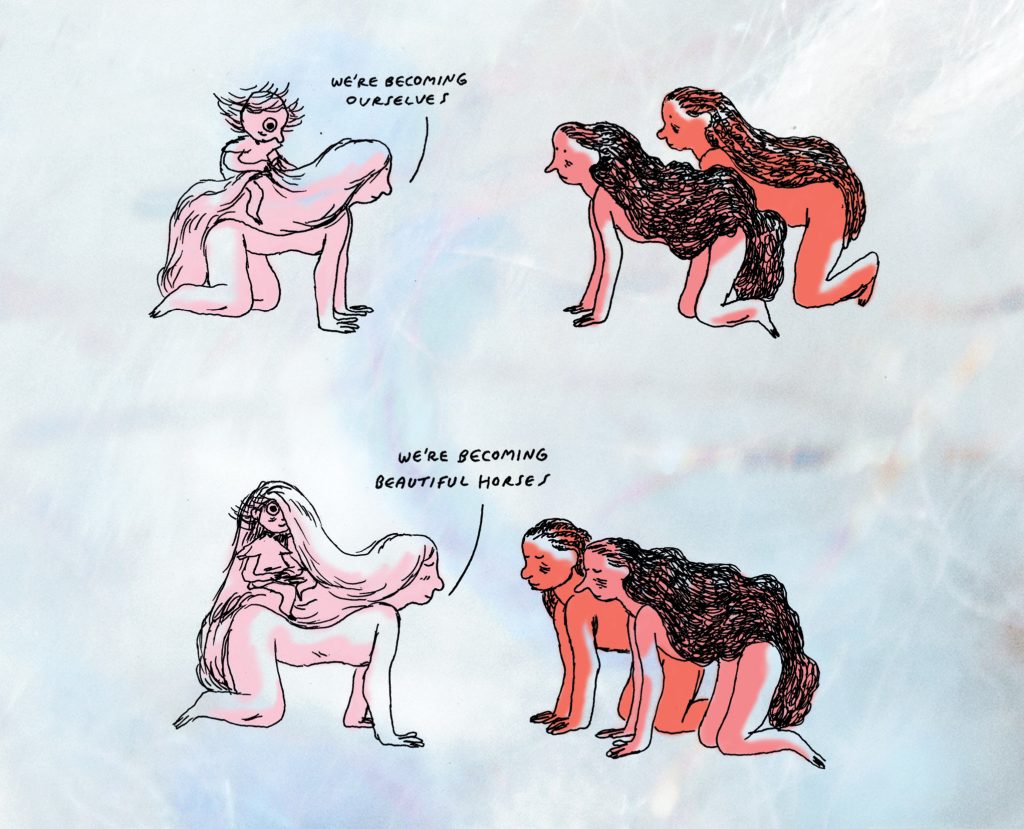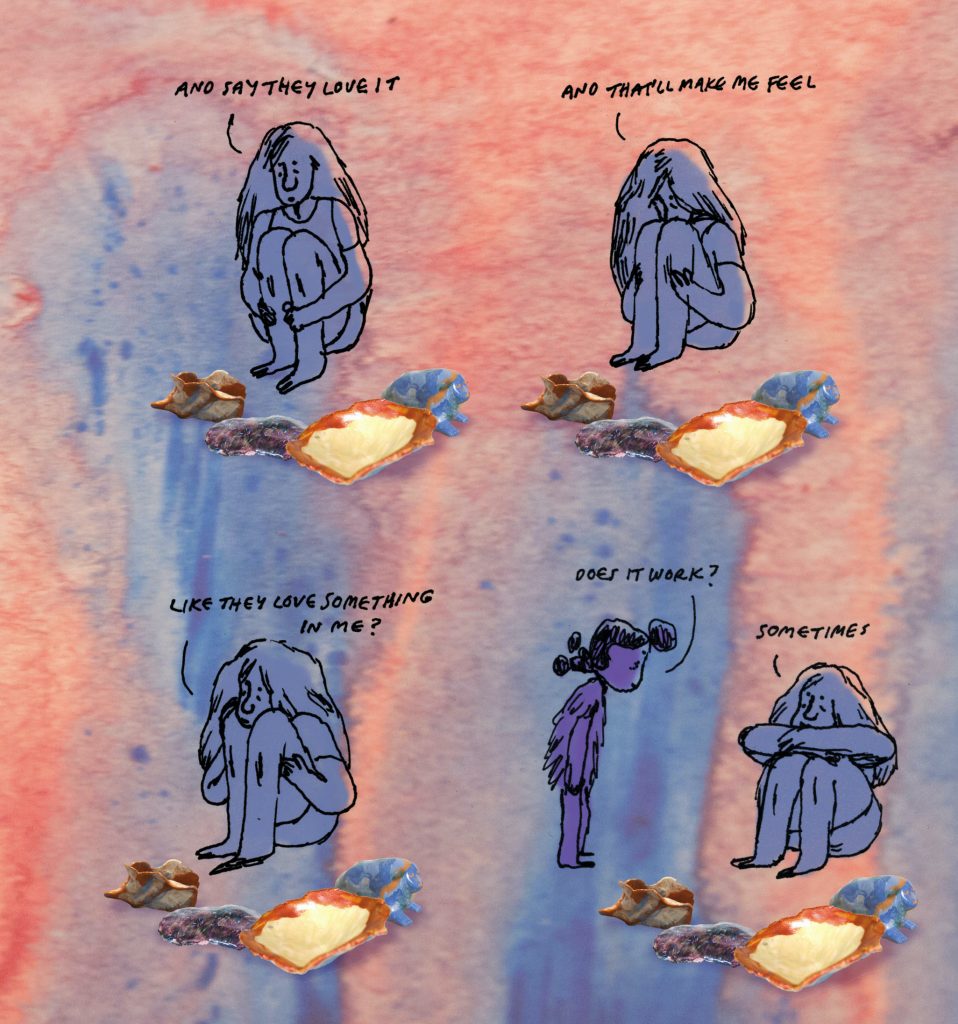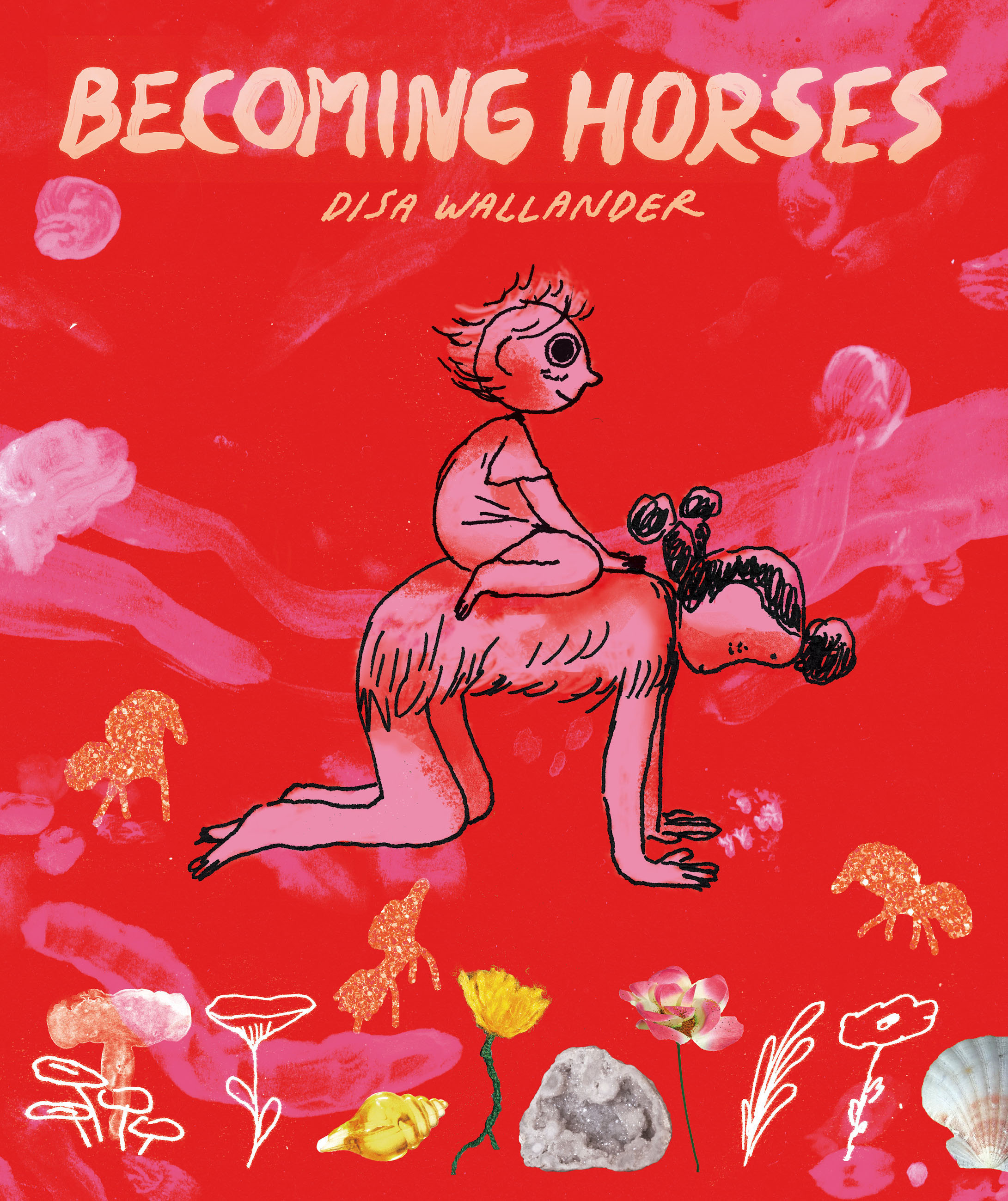Disa Wallander is a Stockholm cartoonist who experiments with collage and physical objects in her comics. In Wallander’s Becoming Horses (published by Drawn & Quarterly) the boundaries between the body and the exterior world blend. Characters transform into horses, get eaten, and weave between dimensions as the art also transitions between drawing, painting, textiles, and much else. At some moments, profound meditations softly swish across the page with ease. At others, Wallander inverts the sense of seriousness by questioning perception itself.
Becoming Horses is a trippy meditation on art and self-identity. I wrote to Wallander to ask her about her material and philosophical methods.

NATHAN SCOTT MCNAMARA: Your art involves many different elements: photography, painting, textiles, paper, porcelain, rocks, plants, etc. Would you describe the physical spaces in which you make your work? How are they organized and how do you function within them?
DISA WALLANDER: I have a studio, in which I arbitrarily keep some things. And an apartment in which I keep the rest. Some of it in boxes, some of it in little displays. And then I have the world, which is also where I work, to go out and take photographs and find things.
Organization is tragically lacking in any area of my work; I wish that my inclination for collecting things somehow came with the ability to sensibly store and arrange them. “Collecting” might be a generous word for it, actually. I’ve always just liked picking up trash. Being an artist is a good excuse, because absolutely anything can be “materials” that “might come in handy,” but I’m pretty sure that even if I never made art again, I’d still be picking up the same amount of rubbish. So the line between “work” and “life” is really very thin when it comes to materials that I accumulate. Also, a lot of the stuff I use in my work has some sentimental value. Some of them are things kept from childhood. For over 20 years I’ve kept a gummy candy in a little round box. It’s gone completely hard but never rotted! I try not to be sentimental in my writing, but I’m obviously very sentimental about the things I use as a backdrop for my comics, and that’s a nice thing to bounce off of, a bit of comfort in my image-world.
Parts of Becoming Horses feature characters searching for and even at times transforming into horses. Why horses? Can you tell me about your relationship with horses growing up and currently?
I don’t have much of a relationship to horses. One time in my early teens we had to do work practice for school and my friend convinced me to do it at a stable. So we got up at 4:00 am every day for two weeks to shovel horse dung, and at the end of it they said we could ride the horses as a reward for our hard work — we both declined because, as it turned out, we were both kind of afraid of horses. That’s about the extent of horse interaction I’ve had in my life!
So, as for the choice of horses, they are more like symbols of personal fantasy. It could have been something else, maybe, but I think there are certain things about horses that made them appropriate for the themes in the book. Part of what I was wanting to explore was the notion of beauty as something aspirational, whether in art or in life. The horses in the book represent many things, but one of them is the question of what beauty means for us. Can it be anything, and beauty is just an assigned value informed by norms and standards in society, a reflection of power structures? If there’s such a thing as something universally beautiful, what would it be? Can the experience of beauty be something purely joyful, a feeling of love for an artwork or a flower?
I think of horses as beautiful in a way that seems unique. I don’t know if there’s an animal that we regard as beautiful in quite the same way — maybe there’s something about the way that they have long hair in select places that aligns with some notion of human beauty? Or maybe that’s far-fetched! I’m not sure what it is, but we have a long history of depicting horses in art, going back to cave paintings, and that in itself means that there’s this vast legacy of imagery to call back to — even if I’m not doing it purposefully I can rely on the fact that the reader will have some sense of that history and will bring that into their reading of what happens in the book. It’s a useful context.
Another useful context is that there’s this very gendered culture around horses that is interesting. I’ve never been a part of it but riding and hanging out at the stable seems to be a pretty intense space for young girls to bond. And even though I don’t necessarily think of my characters as girls or women, I think there’s something about that kind of bonding that sort of relates to what I tried to do in Becoming Horses. I wanted the feeling of a secluded universe where things may not always be easy but there is a power in a community that builds its own set of norms, socially and aesthetically.
And on more of a surface level, in modern culture the image of a horse is related to kitsch and fantasy which also comes with an association with girlhood. I drew on that sort of new age, saturated airbrush imagery pretty heavily in the coloring of the book and I had a great time listening to Enya and blending oranges and pinks.

Many of your characters are creators themselves, weaving between elation and frustration while making things. Would you tell me about the ways you move between joy and misery when making art?
I have tried, very purposefully, to eliminate any misery from the actual process of making art. I mean, needless to say, it doesn’t work 100% — some frustration is probably inevitable — but I have to say I’ve been fairly successful. A huge part of this was giving up on all my ideals about craftsmanship in drawing. I used to be a big asshole about drawing and had very rigid ideas about what made a good draftsman. I drew every day, did loads of studies and life drawing, and often made myself totally miserable because I had these insane goals of what I wanted to achieve. I wanted to be “the best” at drawing — but what does that even mean?! I used to make these flowy graphite drawings and color pencil renderings. Then, at some point, I took a few weeks away from drawing, which I remember feeling very strange about, and when I came back I started drawing with this fineliner, and something just clicked and I started drawing differently. Now I still draw almost exclusively with that same fineliner pen, and even though this was years ago now, I still can’t draw with pencil because that muscle memory just sends me straight back to the same place I was in back then with my drawing. It’s weird! Anyway, now I just make these scratchy little character drawings and they make me happy.
Ever since I started using collage, making art has been so much more enjoyable too. I sometimes see people talking about cartooning as this miserable drudgery and I feel lucky in that I don’t relate to that at all. I think if I was making comics in a more traditional way, I would feel that way too — I have tried to, but found it very tedious. But I don’t want cartooning to ever make me unhappy! So I just try to do things in whatever way will give me energy rather than zap it.
That said, misery in life is another thing altogether! Misery in life is unavoidable, and sometimes I can use that for comics, sometimes I can’t. It depends on the kind of misery…
In one comic, a character says she stayed up all night making things hoping that people would see them, say that they love them, and then she would feel like they love something in her. How do you personally navigate the search for external validation when you create?
I’ve pretty much grown up making art on the internet, so that aspect of sharing what I made has always been there. I was on numerous art forums and oekaki boards from my early teens, and that was just how I learned to draw, and what motivated me to get better at it. I honestly find it hard to even separate the idea of making art from the idea of posting it online, those things have just been tied together for me for so long. I don’t think I’m the type who would be making things in isolation, the purpose is to communicate with people. With social media, it’s pretty easy to become caught up in only the validation and that’s not healthy for the artist or the art, and I have many gripes about what social media does to drive that, but I think the unique ability to be seen and recognized for your esoteric little comics and find an audience for that online is pretty great.
I think of comics, and art, more or less like a language. And my guess would be that people want to speak in that language because it lets them express things they couldn’t in any other way. And it doesn’t have to be like, your innermost feelings, but there is so much absurdity and complexity in life that I think we couldn’t possibly process in any other way. I don’t know how we could bear it if we couldn’t share in that weirdness, and I think it’s only natural to want people to affirm that they feel that weirdness too.


Your characters have great style and some of their outfits are even organically attached to their bodies. How do you go about dressing your characters?
I think maybe my main criteria for dressing them is that I don’t want to make them look too modern, or of this world. I want them to feel like they exist in a different universe where clothes work differently. So I think of it as just shapes and usually it’s just based on what I find easy to draw which is either flowy kaftan-like clothing or… leotards. Sometimes there’s just a texture, so it’s a fur or a shrub or something is growing on them. I don’t know. In society clothes signal so much about who we are, and I want to take all that away and have these characters be something more abstract. Their appearance might reflect something about their essence, but I don’t want it to be codified with the signifiers of our world, to the extent that I can escape it.
Do you know what a piece is going to be when you first set out to create it or do you find the path along the way? What is the role of revision in your process?
Most of my comics start with a sentence just appearing in my head, and I’ll run it through to test out different wordings and add onto it until it’s a few lines. It’s a little bit like playing scrabble, just furiously racking your brain for the highest scoring combination of letters. When it’s done, I’ll write it down and usually not much revision happens after that, although I might change a word here or there to better suit the expression of the character when it comes to drawing.
I’m very impatient and if something isn’t working I’d rather just abandon it and make something else, but another reason for not revising much is that I want to keep a sense of mystery for myself. I don’t always really understand why I make something a certain way or what I’m “trying to say” with it. And usually, the less I understand it the more I like it. If I try too hard to write something it’ll inevitably start making too much sense and I’ll risk ruining the thing that made it good, or interesting. The very best things I’ve written have just come into my head, fully formed. Obviously this all comes from having worked hard to find my tools, my skill set, and my voice.

What were the primary influences on the creation of Becoming Horses?
I mentioned beauty in the earlier question about horses, and that was the primary theme for me at the outset. It sidetracked (as it should) and I don’t know how much people would pick up on it now, but that was the core thing that I came back to throughout writing the book. I wanted to investigate my own feeling of love for images, what it is that lights a fire in the heart for a painting — not for what it depicts but for the shapes and the colors and the luster or whatever it may be. Why do we have that capacity? Can “beauty” be a feeling? Can that feeling be close to a feeling of love?
I had read a little bit of art philosophy and aesthetics — I won’t go into it here because it’s too complicated and I’ve forgotten much of it, but it gave me a new way of thinking about art and beauty and I had many burning questions and also many burning answers that I tried and failed to communicate when I started working on the book. Ultimately, I abandoned the project of trying to explain my many epiphanies (definitely for the best) but some of that seeped into the book still.
The other thing that was on my mind a lot was the internet. I was a smartphone resister for a long time, but I got one just when I was starting to work on the book and was very affected by the feeling of now living in the internet at all times, having it always on my person. I feel fortunate to have grown up on an internet where it was the norm to be anonymous, to use a screen name and avatar rather than your real name and real face. I think about how that’s shaped me and my generation. We had easy access to a form of roleplay where you could try out different personas and it was very low-stakes and separate from your real life. That is one of the lasting charms of having an online presence, for me, and even though the internet now is corporate and blood-sucking in a way it wasn’t then, I think there’s still some room for that. You can go online and say, “I’m a beautiful horse,” and in that moment it’s true, because it’s manifest. In the book, the characters are searching for something, for themselves or for a version of themselves. And that thing could be something real and tangible, but it could also be a fantasy that in itself is the answer to the question. What do I want to be? I don’t know, but maybe today I want to be a piece of lint, or a sunset, or something entirely abstract. Consumer culture drives us to states of perpetual longing — for something else, something better, and I wonder whether there’s a way to at least enjoy that longing and claim it for our own purposes, make it into an art, if we cannot rid ourselves of it. In their multitude of ways, I think of these artist characters in Becoming Horses as people finding joy while at the same time being haunted by the obligation to find joy.

One character in Becoming Horses says, “Anything you look at, it gets put inside of you, filling up the body with visions.” What are the things that you’re currently looking at and how are they now taking shape in your mind and art?
Currently I’m looking at flower arrangements a lot! I started following the #ikebana hashtag on instagram and I just love it. I love looking at an artform that I’m completely unfamiliar with, it releases me from any responsibility of interpretation and I can just obliviously enjoy it. The way I see people play with shapes and lines is fantastic. And I think for obvious reasons, art that uses already-existing materials and appreciates them (rather than making something from scratch) really appeals to me. More and more I think of my own work as simply arranging found things and appreciating things that are already beautiful in their own right, like a brush stroke or a texture.
I’m also re-reading Bruno Munari’s A Flower with Love, a sweet and simple book of poetry and flower arrangements made with potatoes and plastic cups amongst more traditional set-ups. It’s full of humor and I’m just so delighted at finding a piece of moss funny, simply because it’s in an unexpected place, arranged with a playful line in the composition. Honestly, I just want to rip off his idea and make my own version of this book, but I think I have to put it through the grinder and see what comes out the other end.


